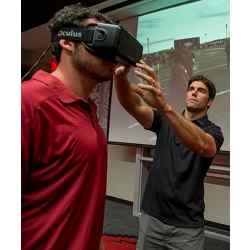
When National Football League (NFL) training camps open around the country later this month, nearly a third of the teams could be utilizing virtual reality (VR) training for the first time. The systems, from start-up STRIVR Labs, which immerse the user in a game-like state, have met with immediate success within the nation’s biggest-dollar sports league, where even slightly deflated footballs have been used to gain an edge.
In the early 1960s, the Dallas Cowboys pioneered the use of computers in football by using them to run its scouting departments and player draft, an advantage that helped lead the team to 20 consecutive winning seasons, the nickname of "America’s Team," eight Super Bowl appearances, and five championships. Yet today the Cowboys, while still one of the most popular and valuable sports franchises in the world, are battling a 20-year Super Bowl drought, and the team is again first out of the gate with new technology. Head coach Jason Garrett says the technology from STRIVR is a "good tool" to expand player development. Much of the rest of the league also appears ready to make VR a technology whose time has come quickly.
Initially envisioned as a way of giving quarterbacks additional opportunities to work in game-like situations outside of the limited repetitions run in live practice, founder Derek Belch said the STRIVR system is being expanded to cover additional positions beyond quarterback, and likely will be used in myriad other environments (such as law enforcement, where Belch believes his tool could help train police officers on how best to handle troublesome situations).
"I knew I had something good, but I couldn’t have expected this (level of success) in the first five months," said Belch. "We knew getting Dallas was a big deal, but it has really opened the floodgates." He predicts as many as 10 additional NFL teams will soon be using STRIVR systems.
Belch began his work with VR for football training at Stanford University, where he was also a kicker on the university’s football team. His professor at Stanford, Jeremy Bailenson, a founding director of the university’s Virtual Human Interaction Laboratory and an expert in VR, encouraged Belch to work on the football project as his master’s thesis, and was so impressed with the results that he became a co-founder of STRIVR. The two first worked at Stanford with head football coach David Shaw to test the equipment and explore ways to shoot the video used to create the VR scenarios.
An initial hurdle was finding an appropriate VR headset. Some early alternatives created a sense of seasickness, and in early development Belch and Bailenson used a helmet from his Stanford VR research lab that was tethered to the ceiling and had a price tag of $50,000. A breakthrough came with the release of the first Rift headset developed by Oculus, which retails for $350.
Wearing the headset, the user becomes the center of attention in the filmed action surrounding him or her. In the case of a quarterback, ideally they are positioned in a "pocket" of surrounding offensive linemen and potentially other teammates. In the VR filmed environment the user is fixed, but with the ability to look across the pocket to the field to monitor the position and movement of his teammates and opposing players. As the filmed play proceeds, the user can complete appropriate actions dictated by player movement that simulate being in a live practice.
In addition to the Cowboys and Stanford, STRIVR has signed a number of other college football teams, including those at Auburn University, Clemson University, the University of Arkansas, Dartmouth College, and Vanderbilt University. What has the teams embracing the technology is its ability to engage the user in what feels and looks like a real-world experience within an environment that can be utilized on a flexible time schedule to provide simulated player repetitions that there are not enough time for in live practice. An additional benefit is increased game preparation without the risk of injury.
"It is something I’ve been thinking about for the last 25 years," the Cowboys’ Garrett said. "As a (career) backup quarterback, I could never get enough reps, but I found myself in situations when I had to go into the ballgame and play. We tell players to do ‘mental reps’ (to prepare) away from the field. This is the next step. (In VR) you can see the hand placement (of the other players); you see where they have their feet, where they have their eyes."
STRIVR uses proprietary software on two basic computers and filmed game footage to create the virtual reality training films. During practices, the crew films specific plays that include anticipated defensive coverage schemes such as blitz packages to create the action that players can then practice at their leisure using VR headwear. Cowboys backup quarterback Brandon Weeden said he particularly likes the ability to rewind plays to get a "fine tuning" on nuances that, on the field, happen at "rapid-fire" pace.
The STRIVR software makes the content appear as if it is taking place on a football field, and organizes the playbook in a unique fashion, with built-in algorithms and data collection. Its primary competition currently is from gaming companies, some of which utilize virtual reality headsets. The advantage of VR versus less-lifelike gaming-based platforms has not been a hard sell, Belch said.
"The only real resistance is in getting some coaches to consider a new approach," Belch said. For Garrett and the Cowboys, that required balancing the desire to be a hard-nosed "old-school team" with being innovative. "I do believe it is important to be open to new ideas," Garrett said.
Darrell Dunn is a freelance writer and editor based in the Dallas-Fort Worth area.



Join the Discussion (0)
Become a Member or Sign In to Post a Comment